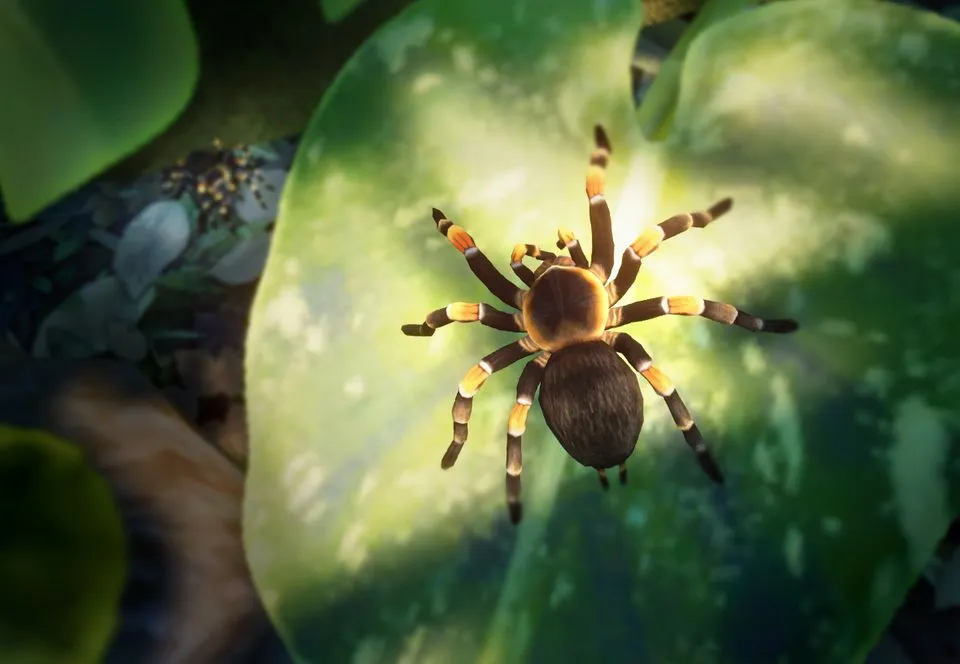Understanding the Redknee Tarantula
The Redknee Tarantula, scientifically known as Brachypelma hamorii, is a popular pet choice for its docile nature and striking appearance. Native to the arid scrublands of the Pacific coast of Mexico, this captivating arachnid has become a favorite among both novice and experienced tarantula keepers. Before you embark on your journey of owning a Redknee, understanding its natural history, habitat, and care requirements is crucial for ensuring its well-being and longevity. This guide will provide you with the foundational knowledge needed to create a thriving environment for your new pet.
Origin and Habitat
Geographic Location
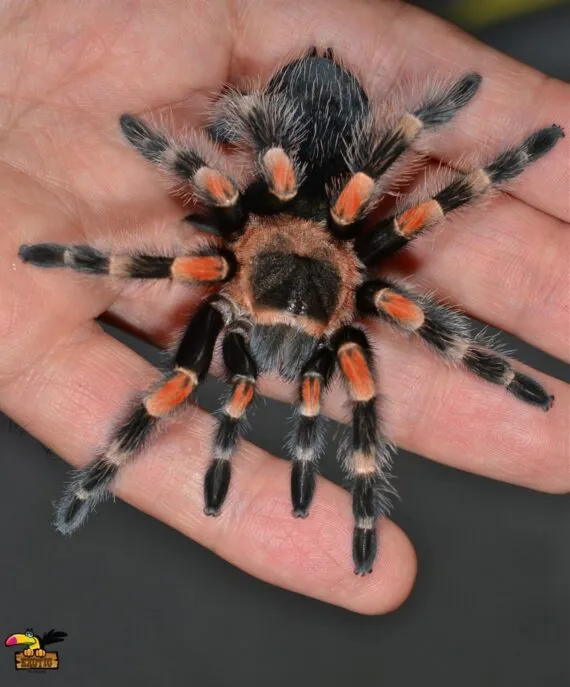
Redknee Tarantulas are endemic to the western coast of Mexico, specifically the states of Guerrero and Michoacán. They are typically found in a range of habitats within these regions, including scrublands, grasslands, and lightly wooded areas. Their distribution is relatively localized, and they are not found in other parts of the world naturally. This limited range makes conservation efforts particularly important to protect their wild populations.
Natural Environment
In their natural habitat, Redknee Tarantulas live in burrows they construct in the ground or utilize existing crevices and burrows. These burrows provide shelter from the harsh climate and protection from predators. The environment is typically dry and warm, with distinct wet and dry seasons. They are nocturnal hunters, emerging from their burrows at night to forage for insects. The substrate in their natural environment typically consists of loose soil, leaf litter, and rocks, which helps them to create their burrows and regulate humidity.
Appearance and Characteristics
Physical Description
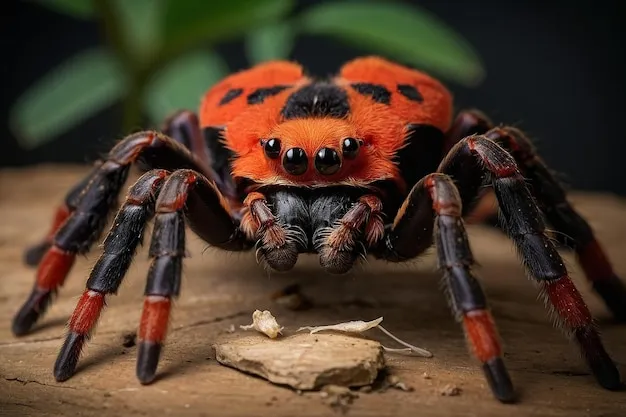
The Redknee Tarantula is renowned for its striking appearance, characterized by a dark body and vibrant red or orange markings on the joints of its legs. The carapace, or top shell, is typically dark brown to black, while the abdomen is covered in urticating hairs. They can grow to a leg span of up to 6 inches, with females generally larger than males. The contrast between the dark body and bright leg joints makes them easily identifiable and visually appealing. A healthy Redknee will have a plump abdomen, indicating it is well-fed and hydrated.
Behavioral Traits
Redknee Tarantulas are known for their relatively docile temperament, making them a good choice for beginner tarantula keepers. They are generally not aggressive but may flick urticating hairs as a defense mechanism if threatened. They are terrestrial spiders, meaning they spend most of their time on the ground. They are nocturnal hunters, being most active during the evening and night. Their movements are slow and deliberate, and they are not prone to rapid bursts of speed. They are generally solitary creatures, only interacting with others during mating season.
Setting Up Your Redknee Tarantula’s Habitat
Creating the right habitat is essential for the health and well-being of your Redknee Tarantula. The enclosure should mimic their natural environment as closely as possible, providing the necessary temperature, humidity, and security to thrive. A well-designed habitat not only ensures the tarantula’s physical health but also allows you to observe their natural behaviors and enjoy your pet to the fullest.
Choosing the Right Enclosure
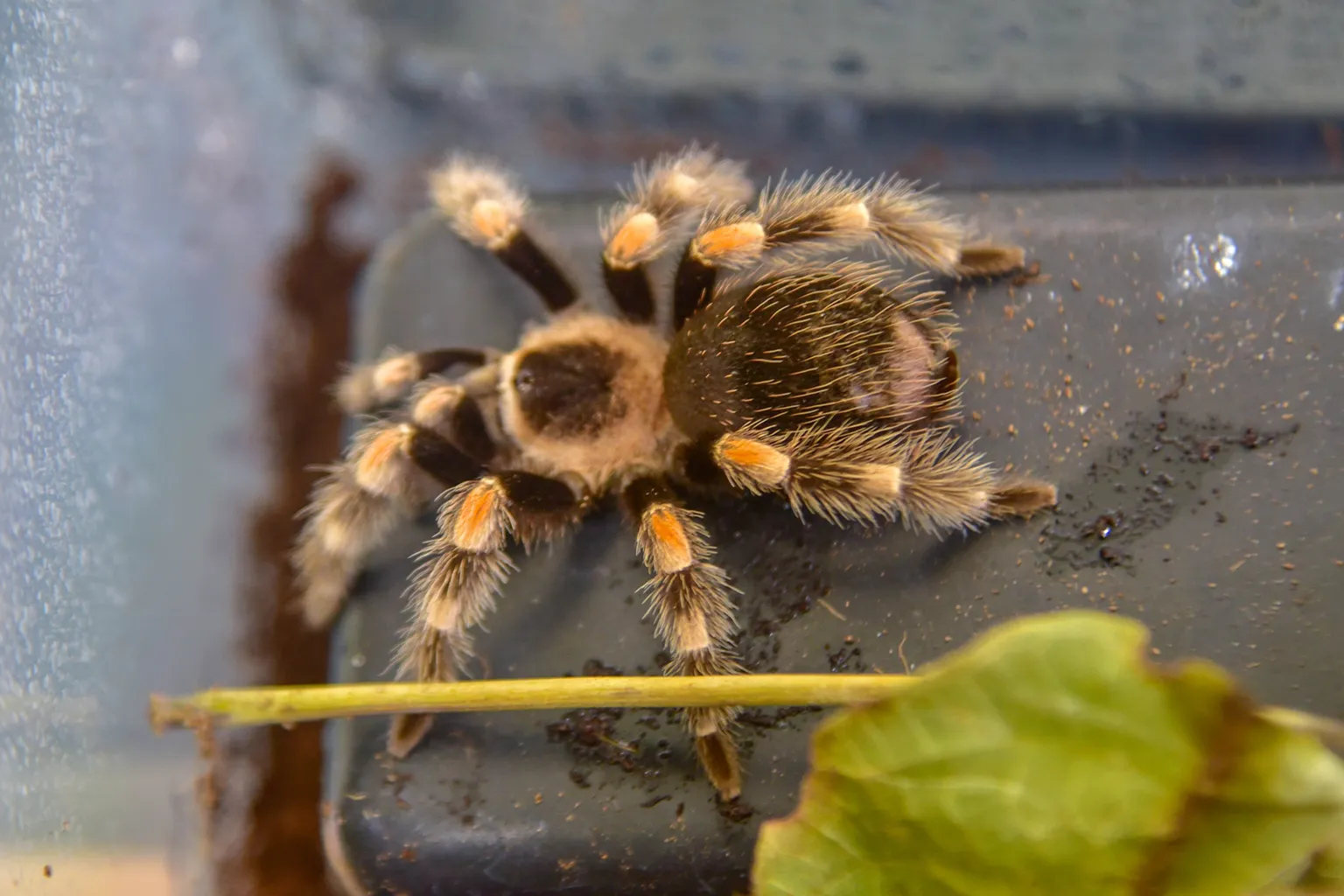
Enclosure Size and Type
The size of the enclosure should be appropriate for the size of the tarantula. A general rule of thumb is that the enclosure should be at least twice the tarantula’s leg span in width and length and tall enough to allow for some substrate depth. For a juvenile Redknee, a 5-10 gallon tank is typically sufficient. As it grows, you’ll need to upgrade to a larger enclosure, potentially a 10-20 gallon tank for an adult. Glass or acrylic enclosures are both suitable, with secure lids to prevent escape. Ensure that the enclosure has adequate ventilation to prevent the buildup of humidity and mold.
Substrate Selection
Optimal Substrate Choices
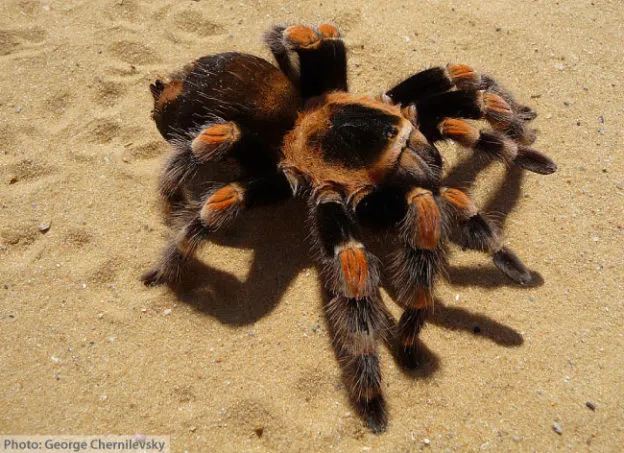
The substrate is a critical component of the tarantula’s habitat, providing a surface for burrowing, retaining humidity, and aiding in molting. A good substrate should be able to hold moisture without becoming waterlogged and should be non-toxic. Suitable substrate options include a mixture of coconut fiber, peat moss, and a small amount of vermiculite. Coconut fiber is a popular choice due to its excellent moisture retention and natural properties. The substrate should be deep enough for the tarantula to burrow, typically 4-6 inches is recommended.
Essential Equipment
Several pieces of equipment are essential for maintaining a proper tarantula habitat. This includes a shallow water dish, a hide or shelter, and a thermometer and hygrometer to monitor temperature and humidity levels. The water dish should be shallow enough to prevent the tarantula from drowning but large enough to provide a source of drinking water. A hide, such as a piece of cork bark or a commercially available hide, provides security and a place for the tarantula to retreat. It’s also beneficial to add some decorations, such as fake plants or rocks, to enrich the environment, but avoid sharp objects that could injure your pet.
Temperature and Humidity Control
Maintaining the correct temperature and humidity is crucial for the health of your Redknee Tarantula. The ideal temperature range is between 75-85°F (24-29°C). You can use a heat lamp or heat pad, but be sure to monitor the temperature to prevent overheating. The humidity level should be maintained between 60-70%. You can achieve this by misting the enclosure lightly with water once or twice a week and ensuring the substrate remains slightly moist. Regularly monitor the temperature and humidity using a reliable thermometer and hygrometer.
Providing Hiding Spots
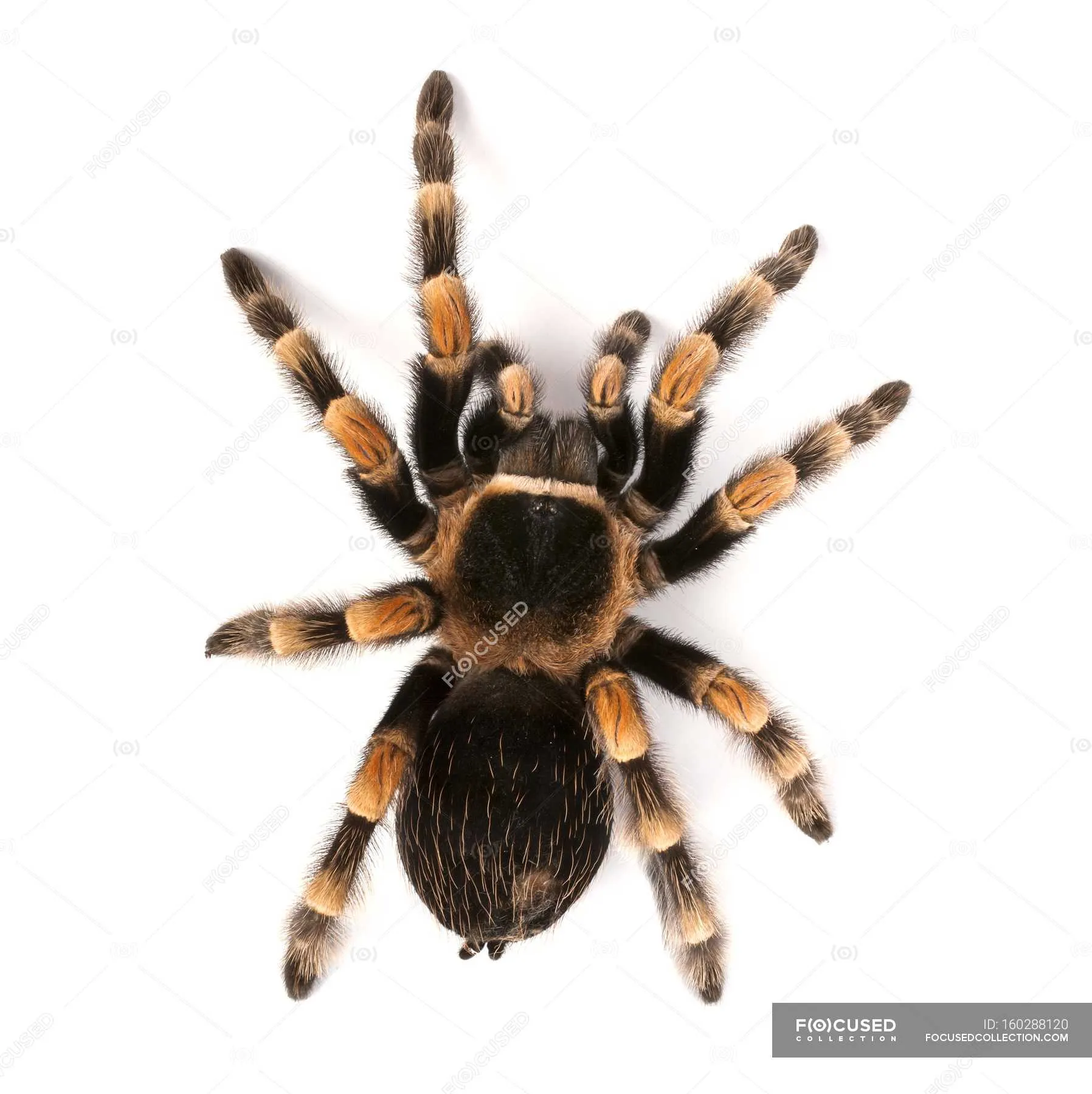
Redknee Tarantulas are crepuscular and nocturnal creatures, they need places to hide and feel secure. Providing at least one hide is essential, as it offers a safe retreat from potential threats and helps reduce stress. Good hide options include cork bark, half logs, or commercially available tarantula hides. The hide should be of appropriate size, allowing the tarantula to comfortably fit inside. Place the hide in a location away from direct heat sources and bright lights to encourage the tarantula to feel safe and secure.
Feeding and Hydration
Proper feeding and hydration are fundamental aspects of Redknee Tarantula care. A well-fed and hydrated tarantula is a healthy tarantula. Providing the right food and water ensures the tarantula gets the necessary nutrients for growth, molting, and overall well-being. Overfeeding can be just as harmful as underfeeding, so understanding the correct feeding frequency and food items is vital.
Dietary Needs
Redknee Tarantulas are primarily insectivores, and their diet should consist mainly of insects. They require a varied diet to ensure they get all the necessary nutrients. The size of the prey should be appropriate for the tarantula’s size; generally, the prey should be no larger than the tarantula’s body. Feeding juveniles smaller prey more frequently than adults is recommended to support their growth. Always remove uneaten prey to prevent stress on the tarantula and avoid the risk of the prey biting the tarantula during a molt.
Appropriate Food Items
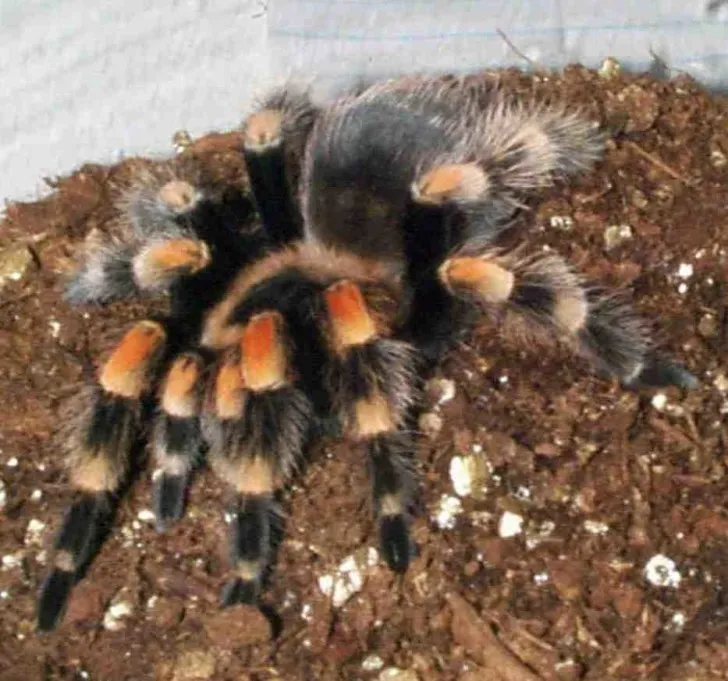
Suitable food items for Redknee Tarantulas include crickets, mealworms, dubia roaches, and other readily available insects. Crickets are a popular choice, but it’s important to gut-load them with nutritious food before feeding them to your tarantula. This ensures that your tarantula receives a more balanced diet. Mealworms can be fed, but they are high in chitin, so it is recommended to feed them sparingly. Dubia roaches are also excellent feeders, being high in protein and easy to care for. Always ensure that the insects are pesticide-free before feeding them to your tarantula.
Feeding Frequency
The feeding frequency will depend on the age of the tarantula. Spiderlings and juveniles should be fed two to three times a week. Subadults can be fed once or twice a week, and adults typically only need to be fed once every one to two weeks. Observe your tarantula’s abdomen, which should be plump after feeding. If the abdomen appears overly large, reduce the feeding frequency. If the abdomen is thin, you might need to feed more often. During molting, the tarantula may refuse food altogether.
Watering and Hydration Methods
Water Source Options
Providing fresh water is crucial for the health of your Redknee Tarantula. A shallow water dish is the best option, as it minimizes the risk of drowning. Make sure the water dish is easy to access and that the tarantula can comfortably reach the water. Alternatively, you can mist the enclosure once or twice a week, which provides moisture for drinking. Ensure that the misting does not oversaturate the substrate or create excessive humidity.
Maintaining Water Quality
It’s important to keep the water source clean. Replace the water in the dish regularly, typically every one to two days, to prevent the growth of bacteria and mold. Use only fresh, dechlorinated water. If you use tap water, allow it to sit for 24 hours to allow the chlorine to evaporate, or use a water conditioner specifically designed for reptiles. Keep the water dish away from the heat source to prevent the water from evaporating too quickly.
Handling and Safety
While Redknee Tarantulas are relatively docile, handling them requires caution and respect. Understanding safe handling practices is critical to avoid bites and minimize stress on the tarantula. The risk of bites exists, even with the most well-behaved tarantulas, and understanding the potential dangers and how to mitigate them is paramount. Always prioritize the well-being of the tarantula and avoid handling if it appears stressed or agitated.
Safe Handling Practices
If you choose to handle your Redknee Tarantula, do so with caution and gentleness. Avoid sudden movements and ensure you are sitting or kneeling close to the ground to minimize the risk of injury if the tarantula were to fall. Wash your hands before and after handling, and make sure to handle the tarantula in a safe environment, away from hazards. Allow the tarantula to walk onto your hand, rather than grabbing it, to reduce stress. It is generally recommended to limit handling to avoid unnecessary stress, especially during molting periods.
Minimizing Risk of Bites
While Redknee Tarantulas are not known to be aggressive, they can bite if they feel threatened. To minimize the risk of bites, always approach the tarantula calmly and avoid making sudden movements. Do not attempt to handle the tarantula if it is exhibiting signs of stress, such as rearing up or raising its front legs. Be aware of the urticating hairs on the abdomen; these can be flicked off as a defense mechanism and can cause irritation. If you are bitten, clean the wound thoroughly with soap and water. The venom of a Redknee Tarantula is not considered life-threatening but can cause localized pain and swelling.
Recognizing Stress Signs
It’s essential to be able to recognize the signs of stress in your Redknee Tarantula. These signs include rearing up, raising its front legs, flicking urticating hairs, hissing, and biting. A stressed tarantula may also become reclusive and hide in its burrow for extended periods. If you observe any of these signs, leave the tarantula alone and avoid handling it. Creating a stress-free environment is crucial for the long-term health and well-being of your pet. Observe your tarantula regularly to become familiar with its behavior and be aware of any changes that may indicate stress or illness.
Health and Common Issues
While Redknee Tarantulas are relatively hardy creatures, they can still be susceptible to various health issues. Recognizing these issues and understanding how to address them is essential for responsible tarantula ownership. Regular observation of your tarantula’s behavior, eating habits, and physical condition can help detect potential problems early on. Providing a clean and well-maintained environment is the best way to prevent health issues.
Common Health Problems
Some common health problems that can affect Redknee Tarantulas include fungal infections, mites, and parasites. Fungal infections can occur if the enclosure is too humid or the substrate is not kept clean. Mites can infest the tarantula and cause irritation. Parasites, such as nematodes, can also affect tarantulas. If you notice any unusual signs, such as lethargy, loss of appetite, or unusual movements, consult with a veterinarian experienced in treating exotic animals. Maintaining a clean environment and following proper care guidelines can help prevent many health issues.
Moulting Process
Moulting is a natural process where the tarantula sheds its exoskeleton to allow for growth. During this process, the tarantula becomes vulnerable and requires extra care. The frequency of moulting decreases as the tarantula ages. It’s important to understand the moulting process to ensure your tarantula stays healthy. Proper humidity, temperature and nutrition play an essential role in this process.
Recognizing Moulting Signs
Several signs indicate that your Redknee Tarantula is preparing to moult. These signs include a loss of appetite, lethargy, a change in coloration, and the tarantula spending more time in its burrow. The abdomen may appear darker and larger before the moult. You may also notice the tarantula constructing a web mat in preparation for moulting. Avoid disturbing the tarantula during this sensitive period. Provide a stable environment and ensure it has access to water.
Post-Moulting Care
After moulting, the tarantula’s new exoskeleton is soft and vulnerable. It needs time to harden. Do not feed the tarantula for a few days after moulting, until its fangs have hardened. Provide ample water during this period. Avoid handling the tarantula until its new exoskeleton has fully hardened, typically a week or two after the moult. Observe the tarantula’s behavior and ensure it is eating and behaving normally.
Conclusion
Caring for a Redknee Tarantula can be a rewarding experience. By understanding their needs, creating a suitable habitat, and providing proper care, you can ensure your pet lives a long and healthy life. Remember to research thoroughly, provide a safe and stimulating environment, and observe your tarantula regularly. With patience and dedication, you can enjoy the fascinating world of these amazing arachnids. Always prioritize the well-being of your pet and seek expert advice if you have any concerns. Enjoy the journey of Redknee Tarantula ownership.
